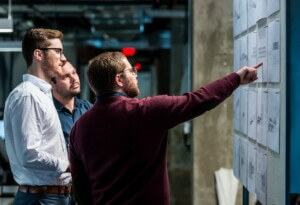Just before Thanksgiving last year, the Brooklyn, New York–based architecture office SO – IL advertised two jobs—designer (2–5 years) and project architect (5–8 years)—via Instagram. The salary range, required by a recent New York City pay transparency law, was listed as $55,000 to $65,000. The post quickly received unwanted attention for the low pay, and overnight the company took to the comments of a follow-up post to clarify its predicament. For a time, the embarrassment opened a window of exchange; some internet commenters used the space to rail against the often-depressing economic predicaments of architectural designers while others came to the defense of small-firm owners everywhere. The kerfuffle arrived as SO – IL is expanding after leaner years; the pandemic had disrupted work worldwide, and the office, like others, shed staff and, for some employees, reduced salaries and working hours.
In December, changes at SO – IL were implemented: Profit sharing was eliminated for associates but retained for senior associates, and salaries were raised “across the board,” according to Idenburg, a move based on projections for 2023 that was in the works before the “Instagram event.” The incident, in his words, “triggered frank internal conversations about what type of office we want to be, including how much work we allocate towards nonprofits. As we are growing as a firm, we are keen on ensuring we can offer a meaningful place of work where people can commit to living well in the city and working on projects they enjoy.” He continued, “The most productive outcome of the event is a better fundamental understanding throughout the office of how the financials work and how we organize our time.” As of this writing, SO – IL’s website lists salary expectations for two outlined positions: “3-5 years of experience: $75,000 – $80,000” and “5+ years of experience: $80,000 – $85,000.”
In a conversation with AN, Idenburg and cofounding partner Jing Liu discussed the incident and the difficulties of practicing architecture today. An edited version follows.
AN: Tell us about your job post on Instagram.
Florian Idenburg: Our website was down, so we posted about job openings at SO – IL on Instagram. What was poorly clarified in the post was that the position was a certain base salary plus profit sharing. This was available for the senior position, so that amount, around $20,000 or so, would make the compensation on par with the market. The post went wrong because we cannot promise profit sharing in a job listing, so people got upset about a pay rate that wasn’t accurate.
We learned a lot from this post. We hadn’t revisited our salaries recently, which meant that we had lost some potential hires, as New York City is expensive. The whole thing was a wake-up call, so in that sense, this has been a positive thing.
Clearly, the post and its aftermath became a lightning rod for a much larger issue. While we did delete the original post, we didn’t want to pretend as if nothing had happened. In a second post, we tried to share the reality of our numbers and the challenges of running an office in New York in our current moment. We try to do work that’s not about profit. For instance, a social housing project we did in Mexico paid $20,000 in fees. We’re interested in working with a good cause and not just with the wealthiest clients.
AN: SO – IL (@solidobjectives) made this post and then deleted it. Then it made a second post, which went into the economics of your practice. You later deleted that latter post, which had over 600 comments. It felt like the medium had collapsed and you were having a conversation with your followers. What can you say about that exchange?
FI: I think social media should be social in the sense that you are communicating. It’s not a one-way medium; there’s a reason why comment boxes exist. Some offices primarily post pretty pictures of their work, but we think there is something nice about being able to have these exchanges.
We deleted the original post because it started to live a life of its own with no nuance. The topic is clearly on everyone’s mind, and that evening of exchange was an exciting discussion. But at some point, there were so many threads that they started to repeat. We gave the same answer over and over, like a game of Whac-A-Mole. At some point, we just needed to go to sleep, although we didn’t sleep much that night.
AN: How does this incident fit into the larger trajectory of your practice?
Jing Liu: We started SO – IL in 2008 at a time when many architects lost their jobs, firms folded, and people went into tech or cinema or things like that. We started as immigrants without trust funds, so we had to be frugal. It was clear to us then that the practice of architecture in America is tied to the market. There is almost no room for culture to be preserved in the face of larger macroeconomic forces.
During the pandemic, the company’s revenue went down by 50 percent. There are a lot of things you can shed, but we tried to preserve the office’s knowledge and keep everyone. There were pay cuts, so in our mind profit sharing was something that could help. This should, of course, be on top of a living wage that is negotiated before work starts.
Like other offices, we plot our expenses against our projected revenue, and if that doesn’t happen, then the only thing you can do is to let people go, which is not a good scenario.
We were trying to have a conversation about this on Instagram, which was a foolish way to go about it. We don’t know where we go from here, but we do need to raise our fees. That’s the first thing.
AN: How do you raise your fees? Would it work, or would the move negatively impact the company? How could organizations like AIA better establish these standards?
FI: We work in many different regions in the world. With the strong dollar, the value of overseas contracts—like in the Netherlands—was reduced by 30 percent or so. We were able to negotiate some adjustments in situations like this.
We also tend to lose money with scope creep. We quickly draw a little bit of landscaping on the balcony, and before you know it, we’re also the landscape designer. This is something we have to work on, as we’re a young firm with designers who want to design everything. So to say “No, you cannot draw a tree here” or “Don’t draw a furniture layout in the apartment” is something to practice. At the start of many projects, people don’t know what will happen, so the architect shouldn’t be the only one with risk during that discovery process.
JL: We know there are certain things we spend time on that will lead to better results, even though the client wouldn’t be able to see that or want to pay for it. There was one thread in the Instagram conversation that talked about the difference between setting the standards and agency in architecture. I thought it was a good point: Where is our agency? In the U.S., many public projects already have fee standards, and there are often fee caps. In many other countries, the standards are very fair, like in Australia or Switzerland. But even with those standards, we know that we go the extra mile in our work—if something budgeted for ten hours takes 15 hours, we know that extra five hours will make a difference. Who pays for that? If it’s the taxpayer, doesn’t the effort stand to make the project better? Maybe it’s easier with private clients who might value quality.
AN: How can you promote better business literacy while advancing a practice’s culture? How can we talk about money more directly?
JL: It’s funny, because we always talk about money in our office. But we’re all in this moment where we don’t know how to talk about money, so maybe that’s why the conversation becomes only about money. We need to balance that topic with other conversations; it’s not about solving one problem and leaving behind all the others.
FI: Because we both teach, we know that in schools most students dedicate their energy toward studio, and there’s still a culture of pulling all-nighters. This semester, I asked everyone to stop designing two weeks before the final deadline to work on time management.
There are two things that I think we need to change in education. One is the studio culture that rushes toward a final presentation with the most awesome things. Making awesome things is important, but time management is also important. What is the essential information that we need now to convey the idea in the best way possible?
The other thing is understanding the costs involved in running an architecture practice. It’s not just a bunch of people and computers. There is an incredible lack of knowledge about things like insurance. Yes, schools have professional practice courses, but they’re often not taken seriously. I hear from our staff that they want to be able to read the contracts and understand what we’re agreeing to.
Another element is that we’re competing on a global market for talent. It’s not just New York. Costs vary. For example, OFFICE KGDVS in Brussels is about the same size as our practice, but the cost of their firm is one third of ours. That’s part of why David Chipperfield has an office in Berlin: London is expensive. Even in the U.S. there are salary disparities between cities.
Again, it’s hard to discuss architectural fees in the U.S. openly. It’s clearer in Germany, for example, where contracts have layers of scopes, and each type of work comes with a percentage. We should be more precise in coordinating the type of work and the fee.
I think the AIA could make strong recommendations about this. The AIA contracts are robust regarding the legal structure, but as agreements relate to money and changes, it’s left to the architect and client to make a deal; there are no real guidelines.
JL: Today, there’s a huge push for unions in architecture. My personal opinion is that I don’t think a union is the right tool. In our office, there isn’t a division between the “capitalists” and the “laborers.” The capital that exists is intellectual capital. Our work is ultimately a collaborative and collective endeavor, and we must solve these issues together.
I do think that our profession should together engage in collective bargaining; maybe the AIA should do more. We need standards about our services. We, as architects who spend five years on a project, shouldn’t be making less money than the real estate brokers who do a few months of emails. That’s ridiculous.
AN: What did you learn at SANAA about creating office culture?
JL: People have this idea that SANAA is a slave den where everyone works long hours and develops unhealthy habits. It was true to some extent when we were there decades ago.
I think what we took from that experience is this incredibly alluring—and necessary, in our mind—collective sense of community. There was that commitment at SANAA that we want to harbor in our office, and that has shaped how we structure it.
From the beginning, we also said we’re not going to do “bread and butter” projects. No matter how hard it is, we don’t want anyone in the office to feel their time is spent supporting someone else. We must be passionate about every project, if it’s making money or not.
AN: What else should we know?
FI: The whole Instagram situation was quite emotional because suddenly we realized the variety of audiences on Instagram. And you don’t just get hearts. We also learned from our daughter that if somebody posts a puke emoji, you have to answer with a “palms up together” emoji. We learned a lot about new ways of communicating. 🤲 🤲 🤲











